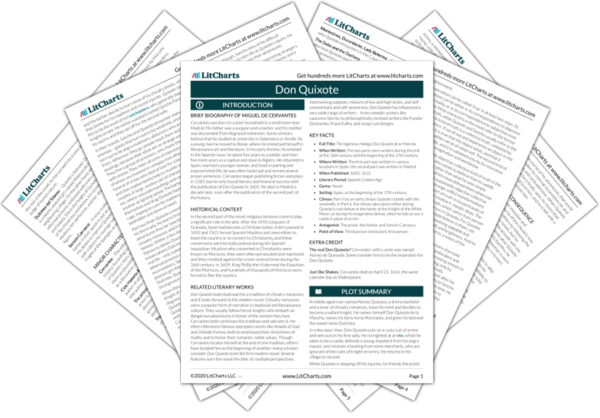Summary
Analysis
Soon after they leave the village, Don Quixote and Sancho come upon thirty or forty windmills. Where there are windmills, Don Quixote sees giants with very long arms, despite Sancho’s objections. He charges a moving windmill with his lance, and it shatters the lance and drags him and his horse painfully across the ground. When Sancho runs over to help him, he tells his squire that the same enchanter that stole his library must have turned the giants into windmills at the last moment.
Quixote saw the inn as a castle from the beginning to the end of his earlier adventure. But this time, he sees giants only at the beginning; afterwards, he sees windmills. He initially looks inward, into the chivalric world where large looming things are always fearsome giants, but the blows of reality force him to look outward.
Themes
They resume their travels in the direction of the Pass of Lapicé. Don Quixote plans to replace his broken lance with a thick branch, as did some fictional knight, and tells Sancho that he will never complain about any pain. Sancho replies that he complains about all his pains.
Though it’s pain that turns Quixote from the imagined to the real, he makes a point of discrediting pain: matters of the body are much less important to him than matters of the soul. Sancho, we see, is the opposite.
Themes
They spend the night in a forest, where Don Quixote makes his new lance from a branch. He stays awake all night thinking about Dulcinea, like the knights in his books. He doesn’t eat breakfast in the morning for a similar reason. In preparation for adventures, Don Quixote tells Sancho that he must not fight knights – only other squires and laymen.
Quixote chooses to ignore pain, exhaustion, and hunger because he’s imitating the ethereal knights in his books. Of course, the fictional knights don’t eat or sleep because the authors chose to omit such crude details. So Quixote’s behavior is life imitating unrealistic art.
Themes
They soon come upon two friars on mules and a coach surrounded by footmen carrying a lady on her way to Seville. Quixote decides that the two friars are enchanters who have abducted a princess. He demands that they release the princess; when the confused friars deny the charges, Quixote charges at them with his lance. One friar jumps off his mule and the other rides away as quickly as he can. Sancho starts to strip the fallen friar, considering the clothes fair spoils of battle, but the friar’s servants beat him up.
Cervantes often puts religious figures in Quixote’s way, perhaps to emphasize the ludicrous gap between intention and consequence. Quixote intends to help a troubled princess; instead, he beats up a monk. We’ve noticed by now that Quixote is very impulsive. The trait is most likely a real world reflection of unreflective, action-loving chivalry books.
Themes
Get the entire Don Quixote LitChart as a printable PDF.

Meanwhile, Don Quixote greets the lady in the carriage and asks her to present herself to Dulcinea del Toboso and describe the adventure in full. The Basque coachman overhears Quixote and tells him to get away, and they begin to battle. The coachman smashes Quixote badly on the shoulder, but the knight grits his teeth and advances. Here, the narrator says, the author stopped his story; but the second author managed to find the conclusion to the tale, which is told in the next section.
On the face of it, Quixote is getting into random destructive brawls with strangers. But there is a clear logic to his actions. A knight must always be dignified and brave, because he is the final stronghold of nobility, courage, and altruism in a decaying world. So Quixote must bravely battle anyone who speaks to him disrespectfully, or else he is betraying the chivalric order and everything it represents.
Themes












